
Steep steps descend from a narrow passageway off Salcombe’s Fore Street. At water level there is a stone jetty, the Ferry Pier, and above and to the right the Ferry Inn enjoys almost perfect views across the estuary. A clinker-built motor boat, with the skipper standing up, is already making its way across the water to pick up the few waiting passengers. Once we are all safely on board, he backs out and turns before heading across the estuary to East Portlemouth; it’s a calm day so this is an easy crossing. The view from the boat always impresses me, low in the water, a cormorant’s perspective. Looking towards the mouth of the estuary, the sea is a dark blue but, in the light breeze, ripples caught in the low sunshine cast a dancing light across the water.
The journey takes only a few minutes but it’s transformative. Salcombe is all cafes and posh clothing shops but across the water we find peaceful long beaches with fine sand. The tide is very low so we follow the strandline, leaving a record of our footsteps in the soft sand. Beachside houses cast long shadows in the low sunshine but, where the sun reaches the beach, it creates pale blues and greens in the seawater, shallow over golden sand, and I imagine the Mediterranean.
Eventually, we reach Mill Bay, a football pitch-sized expanse of undulating, pale sand stretching from the sea to the coast road. Very popular for family holidays in summer, today it is all but deserted. On one side of the beach, the low tide has exposed a long, green, seaweed-covered slipway with prominent metal rails and stone teeth. This was built in 1943 by the US navy to support landing craft during the Normandy landings. It’s hard to imagine the beaches and the estuary filled with ships awaiting the assault on occupied France.
The rear of the beach is fringed with sand dunes bound together with scrubby grass. One exposed vertical face is peppered with holes, burrows for insects, and several black and yellow striped wasps are moving about the nest area in a proprietorial manner. Longer and sleeker than the better known common wasp, these are field digger wasps, solitary insects that dig tunnels in the sand and provision them with dead flies as food for their larvae. A large buff-tailed bumblebee queen is scrabbling in the sand wall as if she is trying to burrow. She looks in good condition but behaves as if something is wrong.
The path leaves the beach to head gently upwards through coastal woodland in the direction of the estuary mouth. The autumn leaf-strewn track meanders through the woods with tantalising views of beaches below. In today’s light, the colours of the sand and water glimpsed through the trees look more southern European than south Devon. We emerge from woodland cover into brilliant sunshine and spectacular but slightly hazy views across the mouth of the estuary to the vast green headland of Bolt Head and the sandy beach at South Sands with its boutique hotels. A red, yellow and blue boat passes by purposefully; it may look like a toy, but it is the Ferry that links South Sands with Salcombe town.
The path turns gradually eastwards seemingly cut into the hillside so that we walk with the land falling away to the sea below us and, on the landward side, rising steeply to rocky outcrops. There is much bracken in evidence, already showing the effects of autumn; bright sparks of yellow gorse shoot upwards. We pass a single spike of mullein, a few yellow toadflax and clumps of sheep’s bit with their unruly mops of blue petals. Several stonechats entertain us, fluttering up and down, tail flicking, chatting.
The sea is calm today. From this vantage point, it is a deep blue but where it meets the rocky coastline, the surface shatters into bright fragments in the sunshine. I scan the coastal waters for seals but get a surprise when I see what looks like a person standing on a rock just above the sea. A closer look reveals a large cormorant, sunning itself. Further away, sailing boats take advantage of the good weather and a fishing boat moors close enough for us to read its name through our binoculars.
Eventually, ahead of us we see a curious, white-painted, cylindrical hut, topped with a thatched roof and perched high above the path upon one of the rocky outcrops. Far below the hut is a secluded stretch of sandy beach and in the distance lies another headland, Gammon Head. The thatched hut is the former coastguard lookout at Gara Rock and we leave the coast path to head up to investigate. Behind the lookout there is a new resort/hotel/apartment complex with people sitting in the sunshine enjoying a drink. A row of coastguard cottages was built here in the 19th century and converted into a popular hotel early in the 20th century. Laurence Olivier, John Betjeman and Margaret Rutherford are said to have stayed here, not necessarily at the same time. The old building was knocked down in the last ten years and rebuilt as the new complex.
The old coastguard lookout has glorious views across the sea and coast and it is surrounded by huge banks of ivy. Much of the ivy is in full flower, filling the air with its distinctive sickly-sweet smell. Perhaps it is something to do with the light today but the flower heads on these clumps of ivy appear as almost perfect globes. Multiple pale green lollipops extend from the centre of each flower head in perfect symmetry, like pins in a pin cushion. Each lollipop is decorated with a frieze of pale yellow-headed stamens, creating, from a distance, a sunny halo around the green globe. The ivy flowers attract many insects including more field digger wasps but it is the ivy bees that I am looking for and I am not disappointed. Many of the elegant yellow and black striped-females move quickly about the flowers together with a few hopeful males. The females are carrying large amounts of bright yellow pollen but still feeding.
We drag ourselves away from this extraordinary spot and head back down the inland valley to Mill Bay following an ancient, slightly sunken green lane with farmland either side. This is a green tunnel with muted light, formed by overhanging trees including a long stretch of very old lime trees with dark, gnarled bark and multiple branching trunks. When we reach Mill Bay, we take the coast road back to the jetty. Many of the houses here are closed up; more than 40% of the houses in the Salcombe area are second homes. The chimney of one of these homes is swarming with bees, probably honeybees. The owner will be in for a shock when they next visit!
For a map and further information on this walk click here.

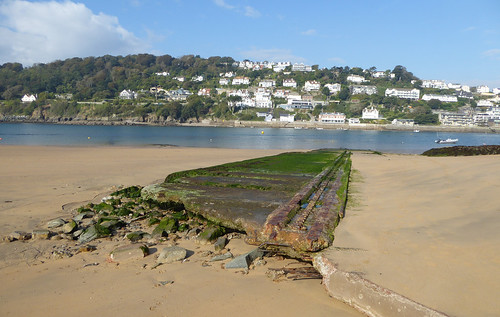

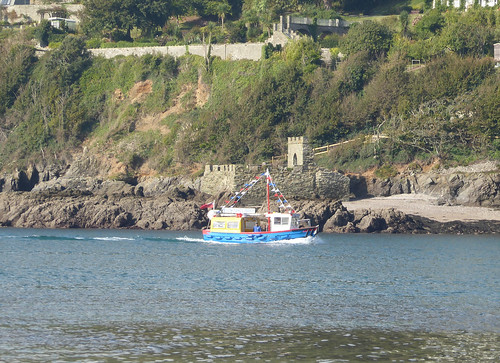

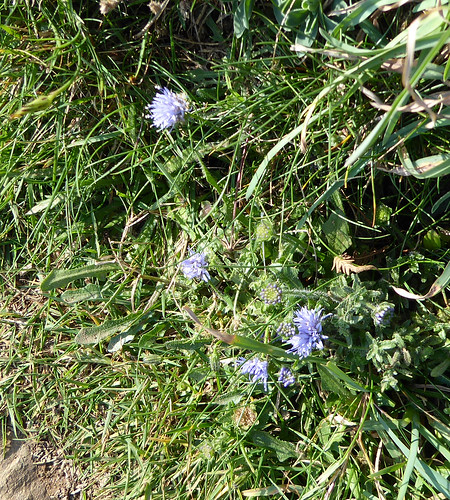
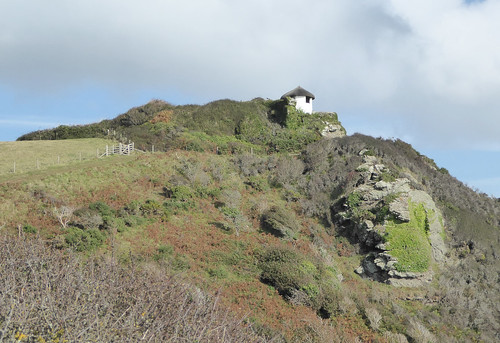
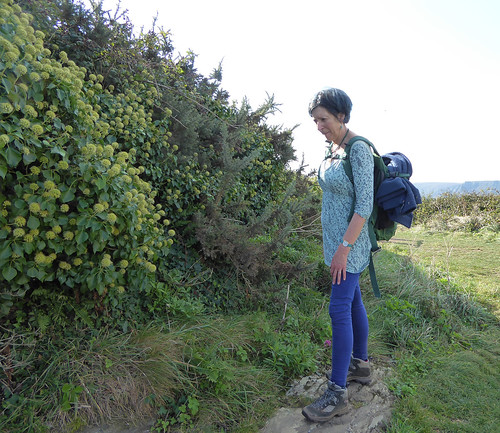
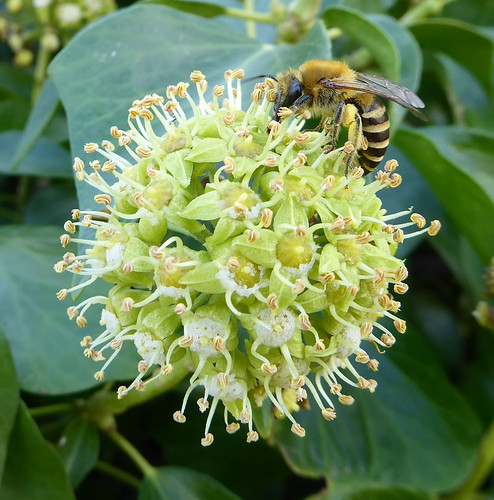
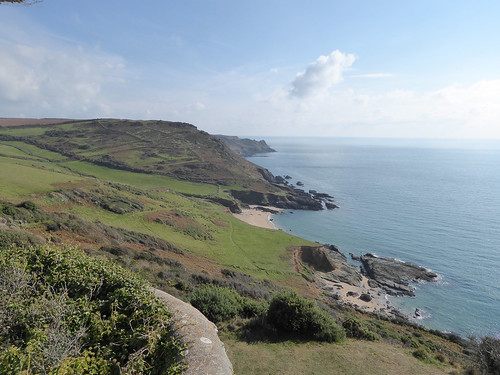
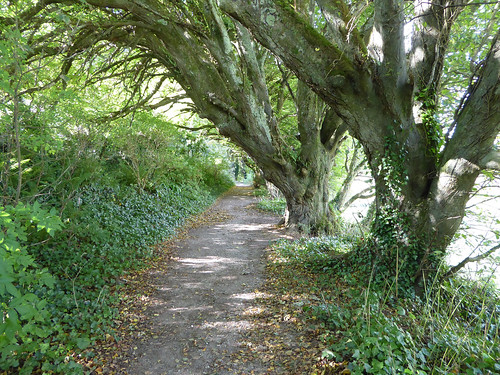



That was an amazing walk, I followed you on Google maps. The photograph of the Ivy bee is beautiful, I had not realised they were so rare in the U.K. until recently and that they were trying to map them. The photograph of the bees flying like smoke out of the chimney is a real gem too. Amelia
LikeLike
Thanks Amelia. I would describe the ivy bee in the UK as having a patchy distribution. By the coast in Devon, which is the part of the UK about which I have knowledge, they seem to be plentiful. In fact for me they are the easiest solitary bee to observe, partly because they forage almost exclusively on flowering ivy so they are easy to find. Away from the coast in Devon they are hardly ever found but that is not true for Dorset and further east (see this map http://www.bwars.com/content/colletes-hederae-2016). Despite this apparently patchy distribution they are spreading northwards and eastwards and that is where the mapping project focuses I think. They are certainly rare in the parts of the country at the leading edge of their range.
How are your ivy bees this year?
LikeLiked by 2 people
this is the third year I have observed “My” ivy bees. The nest site is not as extensive on the path as the first year. They are going “off piste” and that is more difficult to see but they are well. I have never found any more bourgade near us. The ivy had a long season this year and it has kept our honey bees very busy as well.
LikeLike
Glad to hear they are doing well. I get the impression that the nest sites do change from year to year. I suppose it reflects the weather and other conditions. This year the ivy bee season in south Devon seems to have come to an abrupt stop towards the end of October and it coincides vaguely with the onset of cooler, wetter weather.
LikeLiked by 1 person
A delightful walk thanks for sharing it with us.
LikeLike
Thanks Christina, I am glad you enjoyed the walk.
LikeLiked by 1 person
What a beautiful walk, Philip. Exceptional views offering a very peaceful day! In particular, I love the coast guard lookout.
LikeLike
Thanks Debra. I also like the coastguard lookout, it seems unreal with its thatched roof and perched on the top of the cliff but it does mean good views!
LikeLike
Those were wonderful descriptions and images to follow you along this lovely walk. This is a stretch of the coast path that we have still to explore. We have only viewed it from Bolt Head. I was fascinated by the ivy bee and will be now be looking out for them. Sarah x
LikeLike
Thanks Sarah. It is a lovely stretch of coast and all the more interesting for the boat trip across. We have seen a seal here on one occasion and also gannets diving off the coast. The ivy bees are one of my favourites but they are finished now and will not be flying again until August 2017. There will be plenty in Dorset next year.
LikeLike
A beautiful walk indeed. You captured the feel of early autumn. The view from the lookout is spectacular. … and yes, it is hard to imagine the harbor filled with ships and soldiers preparing for the D-Day invasion. Definitely not the serene message you provided here.
LikeLike
Yes it is hard to imagine soldiers here preparing for who knows what. The coast along here was used extensively for preparations and there are quite a few memorials.
LikeLiked by 1 person